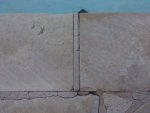Sorry, but unless someone can show me some definitive proof that this problem is as widespread and dangerous as the PBs make it out to be, then my natural inclination is to just chalk their comments up to ignorance and a reluctance to learn something new.
See this post I wrote last month. This is not a new issue and has been discussed ad nauseam for years. The thread Saltwater Pools & Stone/Landscape Damage - It's the Weather? from 2007 was when we started to figure out why some areas of the country saw the problem much more than other areas. That's around the time I found papers describing salt recrystallization pressure and when we saw that in areas of the country with regular summer rains to dilute splash-out especially with high humidity that reduces evaporation (e.g. Florida) that didn't have issues while other areas that were much more dry in the summer and had low humidity (e.g. Texas, Arizona) had more issues and that this also correlated with the type of stone (i.e. softer stone used in Texas).
This is absolutely positively not some sort of made up problem. It is real. And because it is related to salt splash-out and evaporation, it happens faster at higher salt levels. It still happens in non-SWG pools but the effect is non-linear because if one is below the threshold where the splash-out builds up salt faster than it is removed, the problems will not be seen. Even when splash-out builds up, if it does so more slowly due to lower salt levels in non-SWG pools then it may take 2-3 times (or more) longer for the same damage to occur. Note that Australia doesn't see this problem (much) in spite of their 5000 ppm salt levels in their SWG pools (SWG systems were invented and first sold in Australia) because they are very used to high salt due to their ground salt levels and as such they simply don't build pools with features that are sensitive to salt (i.e. soft stone) and they use high-grade metal materials whenever possible.
Fortunately there are ways to mitigate the problem, most notably by sealing soft stone and concrete. Another technique is to frequently wash the splash-out areas.
Note that stone/concrete corrosion is not the only downside to SWG systems. Metal corrosion is another factor and again there are non-linear effects. If lower quality stainless steel (i.e. 304 instead of 316) is used or if aluminum is used (as with header bars that are sometimes immersed in "vanishing" electric safety covers), then these can get corroded. Having an aluminum over-track for a cover is particularly bad as shown in this post. Except for this latter splash-out issue, metal can be protected by using higher quality including cupro-nickel or titanium heat exchangers instead of copper and by electrically connecting a sacrificial zinc anode to the bonding wire and burying the anode in moist soil. See this post for some heater warranties and cupro-nickel claims relative to corrosion.
SWG pools have a lot of advantages, but to ignore their disadvantages and to not know when they work well nor how to mitigate possible issues is being biased, which of course is what many manufacturers of SWG systems did for years. Are Texas PBs going overboard by requiring riders or refusing installation of SWG systems? Yes, because if they simply took the care to design their pools appropriately for such systems, including explanation of required maintenance, then there wouldn't be so many problems.


